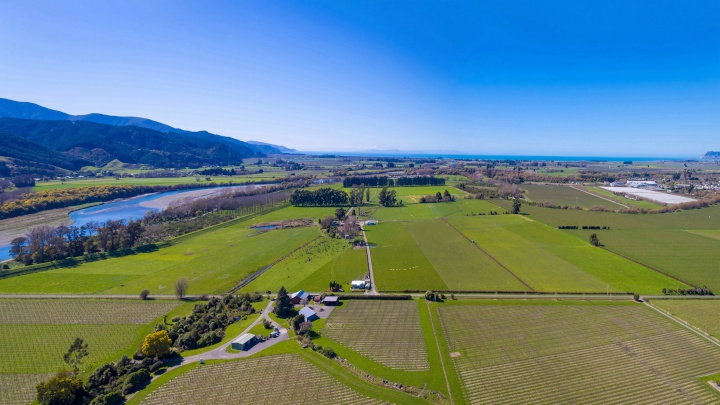Iconic Marlborough block on the market
17.10.19
Iconic Marlborough block on the market for the first time in five generations

For the first time in five generations, land offering a blank canvas to establish viticultural planting has presented itself for sale in New Zealand’s premium grape growing region.
The 73 hectare “Dunsandle Shades” property on Hillocks Road in the Wairau Plains backs onto the Wairau River, and is surrounded by vineyards of some of the country’s leading wine companies.
The property is offered for sale by Bayleys Marlborough salesperson Andy Poswillo in a tender process closing 10am Tuesday 12 November.
The opportunities it presents are testament to the strength of the region’s wine sector, an industry that was non-existent when the property was first purchased.
First bought by Robert Hillock back in 1866 for the princely sum of £300, Dunsandle Shades has been carefully farmed as a pastoral operation ever since and most recently run as a 240 dairy cow farm, a rarity in the heavily vineyard planted region.
Mr Poswillo says with land use changes in the region and strong vineyard returns, the property’s appeal is heightened by being one of the few remaining bare pastoral blocks on the Wairau Plains.
“Having been farmed as a dairy unit the property comes with a very generous 2950 cumec per day irrigation consent across the entire 73 hectares. This is more than enough to serve a viticultural operation,” he says.
The property has a mix of Grovetown silt loam, Spring Creek and Gibson loams. The natural fertility of these well suited soils has been enhanced with several generations worth of careful fertiliser application, with pH levels ranging from 5.8 to 6.4, and Olsen P phosphate levels from 17 -54.
The
relatively uncluttered layout and completely flat contour
make conversion to grapes an easy, cost effective
move.
“And we have a property that is sitting amongst esteemed company in terms of vineyards in the area. It offers the opportunity for a corporate buyer to start from scratch with their vineyard layout and varietals, or for investors who may want to develop it and then lease it back to a wine company.”
Neighbouring vineyards are
returning consistent and high grape yields of 18-20 tonne a
hectare for Sauvignon Blanc, by far the region’s most
popular grape variety. However, the potential to mix up
varietal plantings exists, with Pinot Gris and Chardonnay
also showing good yields in the district.
The property comprises of three titles and expectations are that they will be sold together with planting plans already completed indicating an exceptional utilisation of available area for plantings.
Thanks to the present land’s pastoral operations the property also comes with a good level of capital improvements including a quality manager’s house, a three bedroom cottage and assorted sheds.
Mr Poswillo expects to have strong interest from investors in the property, given the appeal vineyard leasing holds in today’s low interest environment.
Vineyard leases can offer potential returns of six to seven percent on reliable Sauvignon Blanc grape plantings, with varietals offering lower yields returning 4.5-5.5 percent.
In a region getting close to running out of bare land for expanded plantings, leasing options offer a rewarding option for both the wine company seeking access to more grapes and investors wanting a secure tenant for their investment.
Prospects for New Zealand’s wine sector are buoyant thanks to long term efforts overseas to build a reputation for high quality, sustainable production, and growing consumer preferences for fresh New World style wines like Sauvignon Blanc and Pinot Gris.
“What we have here is the opportunity to participate in a sector delivering sustainable, solid returns to its participants, on a property that represents one of the few remaining bare land areas in the Marlborough region.
“It’s very rare for one like this to come to the market, and we anticipate interest will be strong from throughout the sector,” Mr Poswillo says.
ends


 Science Media Centre: Cyclone Gabrielle's Impacts On NZ's Ecosystems - Expert Reaction
Science Media Centre: Cyclone Gabrielle's Impacts On NZ's Ecosystems - Expert Reaction RNZ: Parts Of Power System Could Be Out For 36 Hours In Event Of Extreme Solar Storm
RNZ: Parts Of Power System Could Be Out For 36 Hours In Event Of Extreme Solar Storm NZAS: New Zealand Association Of Scientists Awards Celebrate The Achievements Of Scientists And Our Science System
NZAS: New Zealand Association Of Scientists Awards Celebrate The Achievements Of Scientists And Our Science System Stats NZ: Retail Spending Flat In The September 2024 Quarter
Stats NZ: Retail Spending Flat In The September 2024 Quarter Antarctica New Zealand: International Team Launch Second Attempt To Drill Deep For Antarctic Climate Clues
Antarctica New Zealand: International Team Launch Second Attempt To Drill Deep For Antarctic Climate Clues Vegetables New Zealand: Asparagus Season In Full Flight: Get It While You Still Can
Vegetables New Zealand: Asparagus Season In Full Flight: Get It While You Still Can 



